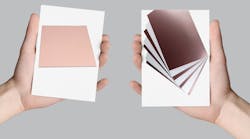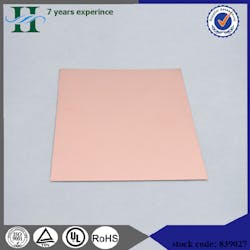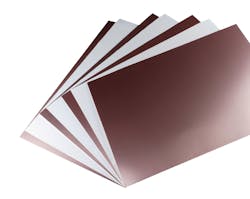Download this article as a.PDF
Materials for printed circuit boards (PCBs) can contribute a great deal to the success or failure of a final circuit design, since those materials affect thermal behavior as well as the electrical and mechanical characteristics of the circuit. At one time, the choice in RF/microwave circuit-board materials was simply between a “hard” or rigid circuit material, typically based on some form of ceramic material, and a “soft” or flexible type of circuit material, often based on Teflon or polytetrafluoroethylene (PTFE) with some form of filler.
The number of circuit material choices has grown with time—with circuit materials now available optimized for specific types of designs, such as antennas, or even frequency ranges, such as millimeter-wave frequencies—although most of the materials can still be categorized as being hard/rigid or soft/flexible in nature. Reviewing some of the differences between the two basic types of RF/microwave circuit materials may help clarify when it makes the most sense to use one type or another for a particular high-frequency application.
Hard circuit materials are typically based on some form of ceramic base, such as alumina (Al2O3), aluminum nitride (AlN), and beryllium oxide (BeO). Hard or rigid materials also serve as substrates for many integrated circuits (ICs), such as gallium arsenide (GaAs), gallium nitride (GaN), silicon (Si), and silicon carbide (SiC). Soft circuit materials are generally formed from an epoxy or plastic, such as PTFE forming a coating around a glass weave, or with some form of glass or ceramic filler to provide strength and rigidity to the plastic dielectric material.
Dielectric materials used for RF/microwave PCBs must undergo different processes, such as metallization with conductive metals such as copper or aluminum, and drilling of holes for mounting of components on PCBs and mounting of boards in enclosures. It has long been one thermoset plastic laminate in particular, glass-reinforced epoxy material known as FR-4, which has represented a kind of industry standard in terms of ease of drilling and metallization. FR-4 (Fig. 1) has made possible low-cost production of PCBs with reasonable performance at RF/microwave frequencies. It is formed of woven-fiberglass cloth with an epoxy resin binder. The FR stands for “flame retardant.” It is more flame retardant than G10 materials and so has largely replaced them.
FR-4 is relatively flexible and easy to machine and position as PCBs within larger enclosures, but suffers high dielectric loss (dissipation factor) at microwave frequencies. These high losses make it poorly suited for high-speed digital circuits or high-frequency analog applications above a few GHz.
Materials engineered for low dissipation factor at higher frequencies, including flexible circuit materials based on PTFE such as RO3000 and RO4000 (Fig. 2) from Rogers Corp. Less-flexible ceramic circuit materials such as alumina circuit materials from Kyocera commonly used in automotive millimeter-wave-frequency packaging are better suited for use with circuit transmission lines at microwave and millimeter-wave frequencies, although with considerably higher price tags than FR-4 materials.
FR-4 is an example of a thermoset plastic resin material, a heat-cured hydrocarbon resin. It requires a hardener or accelerator system to reach its thermoset stage. In contrast, flexible circuit materials based on PTFE are thermoplastic materials. Compared to thermoset plastic resin materials, PTFE/glass fabric materials can achieve tighter thickness tolerances across a sheet of material for good consistency in Dk and dissipation factor (dielectric loss) across the material.
Flexible circuit materials based on PTFE such as RO3000 and RO4000 have gained in popularity because of their ease of machining (quite similar to FR-4) and their low dielectric losses at microwave frequencies. They provide excellent extended high-frequency performance and are often combined with FR-4 and other circuit materials in multilayer circuit configurations to achieve cost-effective use of the different circuit materials for different (non-RF) functions.
Circuits based on soft-type RO4350B laminates can be manufactured using standard FR-4 multilayer circuit processes. RO4350B has a hydrocarbon/ceramic base, with very low dielectric loss at RF and microwave frequencies. Multilayer constructions can be formed by combining RO4350B materials with Rogers 4450 prepreg, or even by combining the high-frequency circuit materials with standard FR-4 prepreg materials.
Cost-effective design approaches often restrict the caps or end materials of a multilayer circuit stackup to the RO4350B materials where the performance is most needed, implementing less critical RF/microwave functions to FR-4 or other circuit materials in the stackup. In this way, the overall cost of the multilayer circuit stackup is managed without sacrificing electrical performance.
Soft circuit materials based on PTFE thermoplastic materials have low moisture absorption compared to thermoset materials. The moisture absorption can cause variations in the impedance of transmission lines fabricated on that material. PTFE/woven glass materials generally meet the flammability requirements of UL-V0 without the addition of flame retardant. Microwave materials based on thermoset resins generally require addition of flame retardant to meet UL-V0, which in turn can lower the copper peel strength, or materials based on thermoset resins will not meet UL-V0 requirements for the thinnest of materials.
Some basic differences in power-handling capabilities between more rigid PCB materials such as alumina and softer, PTFE-based circuit materials makes the former types of materials better suited for higher-power portions of a system, such as its dc bias or RF power amplification. In creating a multilayer circuit stackup using different circuit materials, a key requirement is for a compatible bondply material that is capable of providing reliable adhesion between two different circuit materials, such as ceramic and PTFE-based circuit materials, in a multilayer circuit stackup.
The thermal characteristics of the different materials, such as coefficient of thermal expansion (CTE), should also be compatible to avoid irregularities in expansion and contraction with temperature at interfaces between two different circuit materials.
Alumina or aluminum oxide (Al2O3) circuit material is among the most popular of hard circuit substrate materials due to its excellent electrical and mechanical properties. However, for a ceramic circuit material with much higher thermal conductivity than the other hard or soft circuit materials, as might be used to manage heat from the active devices of a power amplifier, aluminum nitrate (AlN) has thermal conductivity of 170 W/m-K compared to 26.9 W/m-K for alumina.
Ceramic circuit materials are often used in the fabrication of multilayer thick-film circuits with a few different metallization systems, such as in low-temperature-cofired-ceramic (LTCC) constructions with embedded passive circuit elements.
Tightly controlled material thickness is instrumental in achieving the controlled-impedance transmission lines that are a part of RF/microwave circuitry, and PTFE/glass circuit materials can achieve tight thickness tolerances along with corresponding tight tolerances in material dielectric constant (Dk). PTFE-based circuit materials provide excellent consistency across a board, with many characteristics that make those materials extremely popular for many different high-frequency circuits.



